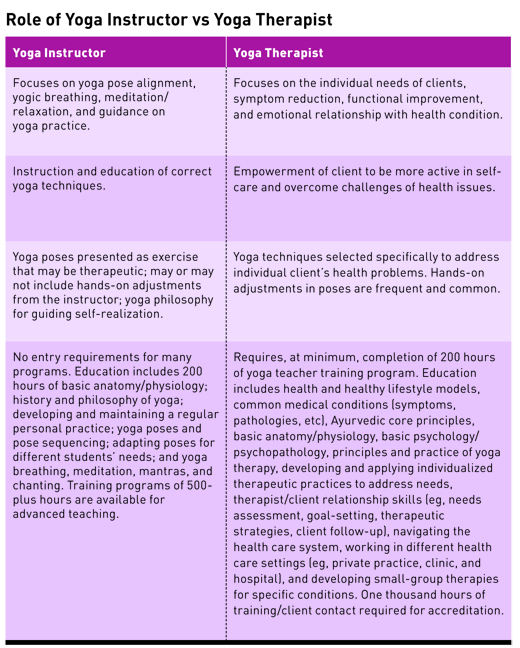 April 2017 Issue
April 2017 Issue
Focus on Fitness: Yoga Class and Yoga Therapy — What's the Difference?
By Jennifer Van Pelt, MA
Today's Dietitian
Vol. 19, No. 4, P. 54
If you ask people why they practice yoga, many will list pain and stress relief as their number one reasons. Yoga is considered therapeutic for several medical conditions, and scientific studies have confirmed benefits for musculoskeletal pain, hypertension, autoimmune diseases, diabetes, anxiety, depression, posttraumatic stress disorder, and cancer recovery.1 Physicians now recommend yoga for many patients. However, taking yoga classes to derive some therapeutic benefit is altogether different from yoga therapy, and a yoga therapist is very different from a yoga instructor. This month, I'll discuss how these two differ from the perspective of the yoga industry and the yoga student.
What Is Yoga Therapy?
Yoga is an ancient practice—thousands of years old—yet yoga therapy is a modern and still-emerging field, according to the International Association of Yoga Therapists (IAYT), which is currently the only professional yoga organization worldwide to provide international accreditation for yoga therapists and yoga therapy training organizations. The IAYT defines yoga therapy as "the process of empowering individuals to progress toward improved health and well-being through the application of the teachings and practices of yoga." Yoga therapy integrates traditional yoga practices (eg, poses, philosophy, breathwork, and meditation) with modern medical and psychological knowledge; it's considered a holistic or complementary/alternative medicine modality.2
Yoga therapy is delivered as a series of sessions, typically one-on-one with the client or in small group sessions if the therapist has multiple clients with very similar health issues. While yoga therapy includes physical bodywork, it's more similar to psychological counseling modalities such as cognitive behavioral therapy than to massage or physical therapy. Yoga therapists perform an intake and assessment interview to determine the client's specific needs related to their symptoms or medical condition. Then, the therapist selects methods to help manage their symptoms, including empowering clients to overcome challenges and improve self-care and functionality. Physical yoga techniques may represent only one small part of an individual client's therapy.3
How Is It Different?
In an article on the distinction between a yoga class and a yoga therapy session, Gary Kraftsow, founder of the American Viniyoga Institute, and a trainer of yoga instructors and yoga therapists, notes that the yoga therapist has "a different focus, a different type of education, and a different skill set" than the yoga instructor.3,4 The table on page 55 describes the differences in focus, skills, and training for a yoga instructor vs a yoga therapist.

Despite efforts to define and standardize yoga therapy by the IAYT, there remains a fine line between therapeutic yoga instruction and yoga therapy. Yoga instructors and yoga participants may not understand the often-subtle differences, perpetuating confusion about just what yoga therapy is. If your clients ask about yoga therapy, explain the difference between taking a class for therapeutic benefit vs seeing an accredited yoga therapist for more individualized therapy. Clients who are being medically treated for conditions like mild anxiety, mild depression, hypertension, or pain associated with an injury or disease (eg, fibromyalgia or arthritis) may benefit from either regular yoga classes (appropriate for their fitness level and health status) or yoga therapy. For clients with an emotional/mental health component to their physical illness, yoga therapy may be a better option.
However, access to yoga therapy may be limited. Yoga therapy sessions are more expensive than yoga classes. And, due to the newness of the field and rigorous training, there are far fewer yoga therapists than yoga instructors; finding an accredited yoga therapist nearby may be difficult.
Benefits
Because interest in yoga continues to grow, and its therapeutic benefits have made headlines, specialized yoga classes are being offered at many yoga studios, rehabilitation facilities, and hospitals. Class types may include yoga for cancer survivors, yoga for chronic pain, prenatal/postnatal yoga, chair yoga for Parkinson's disease or multiple sclerosis, and trauma-sensitive yoga. It's unnecessary for yoga instructors to be yoga therapists in order for these classes to be effective. However, depending on the nature of the class and its intended participants, the instructor should have appropriate training in addition to yoga. For example, yoga instructors with some relevant counseling/psychological training should lead trauma-sensitive yoga (eg, yoga for posttraumatic stress disorder). On the other hand, a compassionate yoga instructor with an understanding of cancer recovery issues can teach a yoga class effectively for cancer survivors; many instructors who have survived cancer themselves have taught cancer-related yoga classes. What's most important is that the instructors and the students in these types of classes understand that the class is for adjunctive therapeutic benefit and isn't yoga therapy as defined by the IAYT.
Assessing outcomes for yoga therapy is challenging due to these inconsistencies in the definition and understanding of yoga therapy in both research and practice. There are numerous published studies that use the phrase "yoga therapy" to describe the practice of a certain style of yoga for therapeutic benefit for patients with a certain medical condition. Study patients may have attended yoga classes or followed yoga DVDs at home. Yoga instructors generally are certified yoga teachers but not accredited yoga therapists. This application of yoga, like condition-specific yoga classes, while therapeutic and possibly effective, doesn't meet the IAYT's definition and standards for "yoga therapy."
If you're considering integrating yoga with your dietetics practice, keep in mind the distinctions between yoga instruction and yoga therapy and be sure to describe your yoga offerings accurately to colleagues and clients.
— Jennifer Van Pelt, MA, is a certified group fitness instructor and health care researcher in the Reading, Pennsylvania, area.
References
1. McCall T. Yoga as Medicine: The Yogic Prescription for Health and Healing. New York, NY: Bantam; 2007.
2. International Association of Yoga Therapists. Educational standards for the training of yoga therapists: definition of yoga therapy. http://c.ymcdn.com/sites/www.iayt.org/resource/resmgr/Docs_Articles/
IAYTDef_YogaTherapy_Ed_Stand.pdf. Published July 1, 2012.
3. Kepner J, Devi NJ, Le Page J, Le Page L, Kraftsow G, Lee M. The differences between yoga teacher training and yoga therapist training and the distinction between yoga teaching and yoga therapy. Int J Yoga Therap. 2014;24:7-21.
4. Kraftsow G. The distinction between a yoga class and a yoga therapy session. Int J Yoga Therap. 2014;24:17-18.
